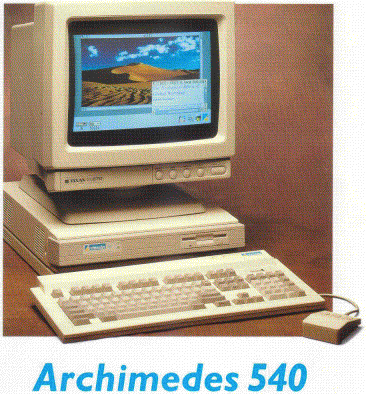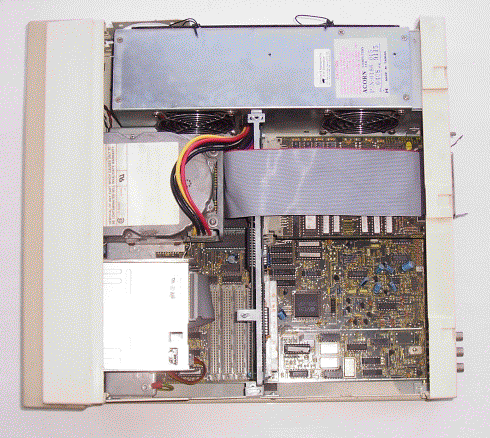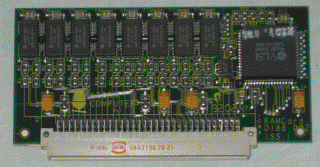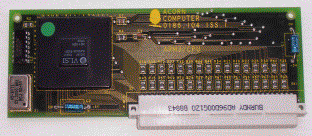



The RISC OS Time Machine - A £3000 computer
Mike Williams and Alan Wrigley review the new Acorn A540...
Would you pay £3000 for a RISC OS machine that doesn't even come with a monitor? No, we didn't think so. However nearly 20 years ago you might have done, especially if you wanted one of the fastest desktop computers on the planet...
This review was originally published in the November 1990 edition of RISC User.
On Thursday 6th September Acorn announced the latest, and fastest, Archimedes designated the A540. Production models were not scheduled to be available until late September, so we arranged to visit Acorn in Cambridge for a day, and have the use of an A540 to ourselves. This is a report on what we saw and experienced. The machine made available to us was a pre-production development machine, which differs in some details from the planned production models. These differences will be mentioned where appropriate, but the main consequence will be that production machines should be even faster than our benchmark comparisons detailed here suggest.

First of all, what is an A540. Externally there is little to distinguish it from the A400/1 range, apart from the model number on the front. However, a second glance at the keyboard shows that the folding transparent keystrip holder has disappeared, leaving a clean raised surface running the whole width. According to Acorn, the plastic strip was considered inappropriate for the markets for which the new machine is intended, but there are no immediate plans to substitute this version for the existing style used with the A400 series. Otherwise the keyboard appears identical to existing models, but Acorn says that production versions will change internally to use the same mechanism as on the A3000.
Turning to the rear of the new machine reveals further differences, one of major importance. This is the SCSI connector on the rear of the SCSI interface card occupying one of the expansion card slots on the A540. The SCSI interface supports an internally mounted Connor SCSI hard disc drive (an integral part of the A540) of nominal 100 MByte capacity (in fact 1024*1024 = 104,890,268 bytes). The specification for this drive indicates an average seek time of 25ms. The data transfer rate along the SCSI bus is quoted at 5MBytes/sec, and that from SCSI host adaptor to I/O bus at 1.25MBytes/sec.
This gives the A540 high speed, large capacity storage. 100 MBytes sounds a lot, it is worth noting that the machine we tested was full to capacity (containing many sprites and other large picture files in a variety of formats) such that at one point a "Disc full" error was generated. However, most users will find 100 MBytes more than enough. The SCSI interface also permits up to seven further SCSI devices to be attached to the one interface as required.
The only other difference in connectors is the presence of three BNC connectors to the rear, allowing (with links correctly set) for independent x and y video signals and sync. Internally, provision has also been made for Genlock and similar video digitiser boards to be connected directly into the Archimedes.
Removing the lid reveals the floppy and SCSI disc drives, the power supply, and the SCSI interface, which leaves room for just three further expansion cards). Underneath all this is the newly designed A540 main board. One major difference compared with previous machines is a clearly delineated area of the board which provides video support including high resolution VGA and super VGA (SVGA), of which more later. Four sockets to the front of the backplane position will accommodate up to 16MBytes of memory, though just 4MBytes is supplied as standard. Each memory board will contain its own MEMC la (memory controller) chip.

Similarly plugged into the main board, and so close to the backplane (which protects it) that it might be overlooked, sits a new processor board. This contains an ARMS processor designed to run at 30MHz, and one of the major factors in the boost to performance. The use of a separate plug-in processor board also indicates Acorn's desire to provide better opportunities for upgrading the processor in the future.
In addition, the processor board will come with a socket ready for the insertion of a new Floating Point Accelerator chip (FPA) as a further boost to performance (Acorn suggested by a factor of 10 in appropriate circumstances for FPA alone).
However, the PPA is not scheduled for release until the summer of 1991, and is intended to be a cost option for the A540.
Not only is the ARM3 processor significantly faster than the ARM2 currently used, but the ARM3 also sports an internal 4KByte cache memory. Fast cache memory holds previously used data and instructions (which might be used again), and significantly improves throughput. The difference is quite noticeable when refreshing the Desktop display, for example. Although the cache can be switched on and off as required, there seem to be no circumstances where not using cache would be the better choice (unless some game program runs just too fast!).
In terms of software, the A540 is identical to the current A400 series with the addition of some new modules: support for the ARM3 including the 4K cache, NewModes which supports the VGA and SVGA standards referred to before, and SCSIFS and other support for the SCSI interface. All other software, including RISC OS (the existing version) will be as supplied with other machines.
To support the VGA and SVGA standards (used by PCs) there are five new modes as shown in table 1. These modes are also supported by multi-sync monitors, such as the Eizo (which we tried) or Taxan 770, but also allow generally cheaper PC VGA and SVGA monitors to be used as alternatives (subject to changing a few internal links to account for the different pin-outs used by PC monitors). If required, the A540 will still support a standard Archimedes monitor. For VGA and SVGA uses, the A540 is configured to monitor type 4.
In use the picture quality achievable with VGA and SVGA is quite staggering Full colour, photographic quality pictures are now possible, and are outstanding in terms of resolution and colour realism Acorn's New Archimedes Flagship: The A540 Indeed, looking at some of the full screen sample pictures it is hard to believe that you are not looking at a photograph, or original colour print. Some of these pictures were produced with the new colour scanner from Irlam which we hope to review soon (see News pages).
| Mode | Standard | Colours | Memory | Pixels |
| 25 | VGA | 2 colour | 64K | 640x480 |
| 26 | VGA | 4 colour | 96K | 640x480 |
| 27 | VGA | 16 colour | 160K | 640x480 |
| 28 | VGA | 256 colour | 320K | 640x480 |
| 31 | SVGA | 16 colour | 256K | 800x600 |
Performance
How fast is the new A540? There are a number of ways to answer this question, First of all, with the 30MHz ARMS, 12MHz memory sub-system and 8MHz I/O the A540 offers a throughput of 13.5 MIPs (Millions of Instructions Per second). That compares with 4.55 MIPs for a PC AT (286 CPU at 10MHz) and 9.59 MIPs for a PS/2 70 (386 CPU at 25MHz).
To try and provide a quantitative comparison between the A540 and other machines in the Archimedes range we ran a number of simple benchmarks, the results of which are shown in table 2. These figures (which should not be treated too precisely) also show the effect of using cache memory.
For reference, IntTest involved repeated adding of two integers, RealTest multiplying two reals, StringTest writing a string to memory, ScreenWrite writing a string to screen. Both A540 and A420 systems tested were fitted with the ARM3 (as standard on the A540, as an upgrade on the 420). Notice the often significant difference between timings with cache off, and with cache on. This also shows how close an A400 series machine can get to an A540 (and the NewModes module supporting VGA and SVGA will be available separately from Acorn). Modes 12 and 15 in all cases were with a standard monitor, new modes 28 and 31 with a multi-sync.
We also checked timings for writing bytes to a file. Choice of screen mode, as expected, made no difference to the result here. Writing randomly to a file gave approximately the same result on the A540 for both floppy and SCSI disc drives, but the same test on an A310 with floppy was slower by a factor of 10. For writing sequentially to file there was no difference between A310 floppy and A540 floppy, but the A540 SCSI drive took half the time, and in this case only was boosted by the use of the cache.
| Mode | 12 | 15 | 28 | 31 |
| IntTest (10,000) | ||||
| A310 | 208 | 259 | - | - |
| A420 (off) | 139 | 169 | 494 | 346 |
| A420 (on) | 47 | 79 | 79 | 50 |
| A540 (off) | 114 | 132 | 233 | 169 |
| A540 (on) | 31 | 32 | 36 | 33 |
| RealTest (10,000) | ||||
| A310 | 178 | 221 | - | - |
| A420 (off) | 120 | 145 | 418 | 292 |
| A420 (on) | 43 | 60 | 76 | 47 |
| A540 (off) | 97 | 114 | 199 | 145 |
| A540 (on) | 27 | 28 | 32 | 29 |
| StringTest (10,000) | ||||
| A310 | 974 | 1232 | - | - |
| A420 (off) | 673 | 822 | 2409 | 1681 |
| A420 (on) | 277 | 423 | 555 | 325 |
| A540 (off) | 555 | 653 | 1150 | 830 |
| A540 (on) | 187 | 194 | 230 | 193 |
| ScreenWrlte (1,000) | ||||
| A310 | 183 | 243 | - | - |
| A420 (off) | 136 | 179 | 452 | 294 |
| A420 (on) | 92 | 159 | 203 | 107 |
| A540 (off) | 161 | 201 | 351 | 245 |
| A540 (on) | 61 | 72 | 98 | 72 |
Subjective performance
During extensive use of the A540, normally with cache on, we were continually impressed by the speed of the system. For DTP work, scrolling a 20 page Ovation document caused no delays at all, and sprites imported into picture frames could be moved around on the page, with reflow of text, very quickly indeed. The A540 is clearly a superb machine for DTP work, and with the choice of software now available compares very favourably with PCs and the Apple Macintosh.


The A540 is equally impressive in graphics work and animation. With the SCSI disc, captured video sequences can be shown in real time, and images processed and manipulated, by ChangeFSI for example, with commendable speed. General Desktop screen work happens so fast that it is a real pleasure to use the system.
Concluding comments
The A540 is an outstanding machine, but at a price of £2995 plus VAT is for the moment probably beyond the pockets of most home users, more so when the cost of a suitable multi-sync or VGA monitor is included. It is also worth noting that the A540 could be turned into an Acorn Unix machine merely by installing the relevant software (though Acorn has no plans at present to make this available separately). The A540 certainly offers outstanding performance for the price, and one can only hope that as with DTP, and increasingly for image processing, video digitising and the like, the software and hardware will appear which will truly exploit this machine to the full.
Foundation RISCWorld